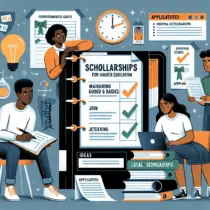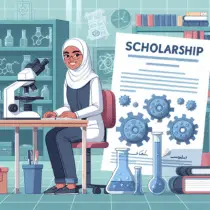Advancing in the field of biotechnology requires more than just a passion for science; it necessitates substantial financial support for education and research. Scholarships play a pivotal role in making dreams of future biotechnologists come true. To help aspiring biotechnologists, this article highlights key scholarships that are influential in molding future experts in the field.
Importance of Scholarships for Biotechnologists
Biotechnology, a field that merges biology with technology, holds the potential to revolutionize agriculture, medicine, and environmental conservation. However, obtaining an education in biotechnology can be financially demanding. Scholarships provide much-needed financial aid, enabling students to focus on their studies and research without monetary worries.
Key Scholarships for Aspiring Biotechnologists
One noteworthy scholarship that benefits future biotechnologists is the $5,000 Astrophysics Research Scholarship, Argentina, 2024. Although it primarily targets astrophysics, it is also available for research-based projects in biotechnology that relate to space science.
Another significant scholarship is the $2,000 Bright Mind Mathematics Grant in Singapore, 2024. Mathematics is a crucial component of biotechnology, especially in data analysis and modeling. This scholarship supports students pursuing interdisciplinary studies where mathematics plays a critical role, including biotechnology.
Specialized Biotechnology Scholarships
Many institutions and organizations offer dedicated scholarships for biotechnology students. These scholarships not only provide financial assistance but also offer opportunities to participate in groundbreaking research and internships.
National Institutes of Health (NIH) Undergraduate Scholarship Program
The National Institutes of Health (NIH) offers scholarships for students committed to careers in biomedical research. The program provides up to $20,000 per year for tuition, educational expenses, and reasonable living costs. In return, recipients are obligated to perform research at the NIH.
The Amgen Scholars Program
The Amgen Scholars Program is an undergraduate summer research program that provides financially-supported research opportunities at some of the world’s leading institutions. This program is open to students who wish to gain research experience in biotechnology and related fields.
The Barry Goldwater Scholarship and Excellence in Education Program
The Barry Goldwater Scholarship is designed to provide financial support for students in the natural sciences, mathematics, and engineering. This prestigious scholarship can provide up to $7,500 per academic year and is ideal for students who demonstrate a strong commitment to a research career.
Regional and International Scholarships
Apart from general scholarships for biotechnologists, there are regional and international scholarships that students should not overlook. These scholarships may not be exclusively for biotechnology, but they often cover multidisciplinary projects that can include significant biotech components.
Gates Cambridge Scholarship
The Gates Cambridge Scholarship is awarded to outstanding applicants from countries outside the UK to pursue a full-time postgraduate degree in any subject available at the University of Cambridge. Tailored for high achievers, this scholarship can support students pursuing advanced biotechnology studies.
Erasmus Mundus Joint Master Degrees (EMJMDs)
Erasmus Mundus scholarships are available for international students studying in Europe. The EMJMDs are integrated study programs delivered by consortia of universities. The scholarships cover the cost of a master’s degree in biotechnology and related fields and offer a unique cultural and educational experience across multiple European countries.
Accessibility and Application Tips
Despite the abundance of scholarships, applying for them can be daunting. Here are a few tips to increase the likelihood of securing a scholarship:
- Research Early and Thoroughly: Start your search for scholarships early. Take note of application deadlines and requirements. Online databases and university financial aid offices are good starting points.
- Tailor Your Application: Customize your application to match the scholarship criteria. Highlight your interests and achievements in biotechnology and show how the scholarship will help you achieve your career goals.
- Seek Recommendation Letters: Strong recommendation letters from professors or research supervisors can significantly enhance your application. Choose recommenders who know you well and can vouch for your academic capabilities and research potential.
- Prepare a Strong Personal Statement: Your personal statement should clearly articulate your passion for biotechnology, your academic achievements, and your future aspirations. Be honest and let your enthusiasm shine through.
- Maintain a Strong Academic Record: Many scholarships require a minimum GPA. Keeping your grades up not only makes you a more competitive candidate but also prepares you for the rigorous demands of biotechnology programs.
Leveraging Scholarships for Career Growth
Winning a scholarship is just the first step. Leveraging this opportunity to advance your career is crucial. Many scholarships come with added benefits like networking opportunities, mentorship programs, and access to exclusive research facilities. Engaging actively with these resources can enhance your educational experience and open up future career avenues.
Real-World Impact of Scholarships
Scholarships do more than finance education; they enable real-world breakthroughs in biotechnology. Recipients often engage in research projects that lead to significant scientific advancements. For instance, a recipient of the $5,000 Astrophysics Research Scholarship, Argentina, 2024 could use the funds to explore how biotechnology can be utilized in space missions, thereby contributing to both the fields of biotechnology and space science.
Similarly, the $2,000 Bright Mind Mathematics Grant in Singapore, 2024 can support a study that uses advanced mathematical models to solve complex biological problems. These interdisciplinary projects exemplify how scholarships can fuel innovative research with far-reaching implications.
Conclusion
In conclusion, scholarships are vital for budding biotechnologists seeking to make their mark in the scientific community. While dedicated biotechnology scholarships like those from NIH and the Amgen Scholars Program offer targeted support, interdisciplinary and regional scholarships also provide valuable opportunities. By taking advantage of these scholarships, students can alleviate financial burdens and focus their energies on innovative research and education in biotechnology. The journey to becoming a successful biotechnologist is demanding, but with the right financial backing, the possibilities are endless.






